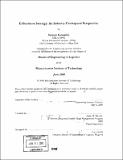| dc.contributor.advisor | James B. Rice, Jr. | en_US |
| dc.contributor.author | Kalanidhi, Sanjeev, 1970- | en_US |
| dc.contributor.other | Massachusetts Institute of Technology. Engineering Systems Division. | en_US |
| dc.date.accessioned | 2005-08-23T14:51:21Z | |
| dc.date.available | 2005-08-23T14:51:21Z | |
| dc.date.copyright | 2000 | en_US |
| dc.date.issued | 2000 | en_US |
| dc.identifier.uri | http://hdl.handle.net/1721.1/8734 | |
| dc.description | Thesis (M.Eng.)--Massachusetts Institute of Technology, Engineering Systems Division, 2000. | en_US |
| dc.description | Includes bibliographical references (leaves 67-68). | en_US |
| dc.description.abstract | The Internet is a communications network that connects computers around the world. It has been around since 1960's. The Internet Phenomena - the recent upsurge in business use of the Internet can be attributed to the World Wide Web or the web. The web uses universally accepted communication protocol and presentation language (i.e. Internet Protocol and Hyper Text Markup Language) that makes it a standard interface - a ubiquitous interface. Businesses are leveraging the Internet to obtain a variety of business benefits. Based on an extensive literature review, this thesis presents a catalogue of 35 distinct business benefits. To obtain these benefits, businesses are undertaking a variety of projects and initiatives. The projects and initiatives, termed as E-business apply the Internet technologies for improving existing business processes, removing barriers within a business, and or among businesses in the supply chain. This thesis organized E-business projects into eight different areas. This thesis explores the Internet Phenomena - it attempts to understand the potential Impacts of the Internet on the supply chain, and proposes some guidelines for management teams interested in choosing E-business projects. By mapping E-business benefits along a typical supply chain, this thesis observes that the Internet is creating structural and operational impacts in the supply chain. The structural impacts appear to result from (a) the growth of a direct channel (b) the presence of new economic agents and (c) new marketplaces. The operational impacts appear to be that (a) the scope of supply chain operations change (b) the scale of supply chain operations are enhanced and (c) the speed of supply chain operations increase. The thesis suggests ten perspectives that may help a management team choose E-business projects. It examines one perspective in detail - the Industry perspective. The industry perspective suggests that differences in industry structures should lead to differences in business needs and requirements, and therefore lead to different e-business opportunities. A hypothesis, based on an industry classification system (proposed by Charles Fine of MIT), was developed. The Internet is a communications network that connects computers around the world. It has been around since 1960's. The Internet Phenomena - the recent upsurge in business use of the Internet can be attributed to the World Wide Web or the web. The web uses universally accepted communication protocol and presentation language (i.e. Internet Protocol and Hyper Text Markup Language) that makes it a standard interface - a ubiquitous interface. Businesses are leveraging the Internet to obtain a variety of business benefits. Based on an extensive literature review, this thesis presents a catalogue of 35 distinct business benefits. To obtain these benefits, businesses are undertaking a variety of projects and initiatives. The projects and initiatives, termed as E-business apply the Internet technologies for improving existing business processes, removing barriers within a business, and or among businesses in the supply chain. This thesis organized E-business projects into eight different areas. This thesis explores the Internet Phenomena - it attempts to understand the potential Impacts of the Internet on the supply chain, and proposes some guidelines for management teams interested in choosing E-business projects. By mapping E-business benefits along a typical supply chain, this thesis observes that the Internet is creating structural and operational impacts in the supply chain. The structural impacts appear to result from (a) the growth of a direct channel (b) the presence of new economic agents and (c) new marketplaces. The operational impacts appear to be that (a) the scope of supply chain operations change (b) the scale of supply chain operations are enhanced and (c) the speed of supply chain operations increase. The thesis suggests ten perspectives that may help a management team choose E-business projects. It examines one perspective in detail - the Industry perspective. The industry perspective suggests that differences in industry structures should lead to differences in business needs and requirements, and therefore lead to different e-business opportunities. A hypothesis, based on an industry classification system (proposed by Charles Fine of MIT), was developed. | en_US |
| dc.description.statementofresponsibility | by Sanjeev Kalanidhi. | en_US |
| dc.format.extent | 68 leaves | en_US |
| dc.format.extent | 6123780 bytes | |
| dc.format.extent | 6123541 bytes | |
| dc.format.mimetype | application/pdf | |
| dc.format.mimetype | application/pdf | |
| dc.language.iso | eng | en_US |
| dc.publisher | Massachusetts Institute of Technology | en_US |
| dc.rights | M.I.T. theses are protected by copyright. They may be viewed from this source for any purpose, but reproduction or distribution in any format is prohibited without written permission. See provided URL for inquiries about permission. | en_US |
| dc.rights.uri | http://dspace.mit.edu/handle/1721.1/7582 | |
| dc.subject | Engineering Systems Division. | en_US |
| dc.title | E-business strategy : an industry clockspeed perspective | en_US |
| dc.type | Thesis | en_US |
| dc.description.degree | M.Eng. | en_US |
| dc.contributor.department | Massachusetts Institute of Technology. Engineering Systems Division | |
| dc.identifier.oclc | 48036219 | en_US |
